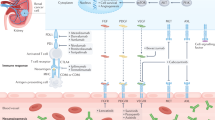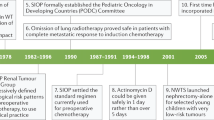Abstract
Wilms' tumor is a renal cancer that predominantly affects children during the first 2 years of life. The continuing success of clinical trials in Wilms' tumor patients over the past 30 years has led to an overall survival of 85%, and treatment-related morbidity has been reduced. Less-aggressive chemotherapeutic regimes are available for patients with validated good prognostic factors, such as low stage and favorable histology. It is becoming increasingly apparent that treatment can be optimized through stratification of patients according to tumor stage and histology. Established treatments for Wilms' tumor include perioperative vincristine and actinomycin, with or without doxorubicin or radiotherapy. Relapsed patients have the option of salvage chemotherapy with ifosfamide, carboplatin and etoposide, as well as high-dose chemotherapy regimes and autologous hemopoietic stem-cell rescue. Further research is required to refine these regimes and identify further the role of additional prognostic factors in this childhood disease. In this article we discuss the most-debated issues and advances that have been made in the management of Wilms' tumor.
This is a preview of subscription content, access via your institution
Access options
Subscribe to this journal
Receive 12 print issues and online access
$209.00 per year
only $17.42 per issue
Buy this article
- Purchase on Springer Link
- Instant access to full article PDF
Prices may be subject to local taxes which are calculated during checkout
Similar content being viewed by others
References
Surveillance, Epidemiology and End Results (SEER) Pediatric Monograph. National Cancer Institute (2004) [http://seer.cancer.gov/publications/childhood] (accessed 8 May 2004)
Habrand JL et al. (2004) Radiotherapeutical innovations in pediatric solid tumors. Pediatr Blood Cancer 43: 622–628
Hoyme HE et al. (1998) Isolated hemihyperplasia (hemihypertrophy): report of a prospective multicenter study of the incidence of neoplasia and review. Am J Med Genet 79: 274–278
Green DM et al. (1993) Screening of children with hemihypertrophy, aniridia, and Beckwith–Wiedemann syndrome in patients with Wilms tumor: a report from the National Wilms Tumor Study. Med Pediatr Oncol 21: 188–192
Diller L et al. (1998) Constitutional WT1 mutations in Wilms' tumor patients. J Clin Oncol 16: 3634–3640
Coppes MJ et al. (1994) Genetic events in the development of Wilms' tumor. N Engl J Med 331: 586–590
Porteus MH et al. (2000) Characteristics and outcome of children with Beckwith–Wiedemann syndrome and Wilms' tumor: a report from the National Wilms Tumor Study Group. J Clin Oncol 18: 2026–2031
Clericuzio CL (1993) Clinical phenotypes and Wilms tumor. Med Pediatr Oncol 21: 182–187
White KS and Grossman H (1991) Wilms' and associated renal tumors of childhood. Pediatr Radiol 21: 81–88
Weese DL et al. (1991) Mapping intravascular extension of Wilms' tumor with magnetic resonance imaging. J Pediatr Surg 26: 64–67
Green DM (2002) Use of chest computed tomography for staging and treatment of Wilms' tumor in children. J Clin Oncol 20: 2763–2764
Montgomery BT et al. (1991) Extended followup of bilateral Wilms tumor: results of the National Wilms Tumor Study. J Urol 146 (Pt 2): 514–518
Coppes MJ et al. (1999) Factors affecting the risk of contralateral Wilms tumor development: a report from the National Wilms Tumor Study Group. Cancer 85: 1616–1625
Paulino AC et al. (1998) Metachronous bilateral Wilms' tumor: the importance of time interval to the development of a second tumor. Cancer 82: 415–420
Breslow N et al. (1985) Prognosis for Wilms' tumor patients with nonmetastatic disease at diagnosis—results of the second National Wilms' Tumor Study. J Clin Oncol 3: 521–531
Beckwith JB et al. (1996) Histological analysis of aggressiveness and responsiveness in Wilms' tumor. Med Pediatr Oncol 27: 422–428
Delemarre JF et al. (1996) The new SIOP (Stockholm) working classification of renal tumours of childhood. International Society of Paediatric Oncology. Med Pediatr Oncol 26: 145–146
Vujanic GM et al. (2002) Revised International Society of Paediatric Oncology (SIOP) working classification of renal tumors of childhood. Med Pediatr Oncol 38: 79–82
Ritchey ML et al. (1988) Intracaval and atrial involvement with nephroblastoma: review of National Wilms Tumor Study 3. J Urol 140: 1113–1118
Shamberger RC et al. (1999) Surgery-related factors and local recurrence of Wilms tumor in National Wilms Tumor Study 4. Ann Surg 229: 292–297
Duarte RJ et al. (2004) Laparoscopic nephrectomy for Wilms tumor after chemotherapy: initial experience. J Urol 172: 1438–1440
Green DM et al. (2001) Congestive heart failure after treatment for Wilms' tumor: a report from the National Wilms' Tumor Study group. J Clin Oncol 19: 1926–1934
Tournade MF et al. (1993) Results of the Sixth International Society of Pediatric Oncology Wilms' Tumor Trial and Study: a risk-adapted therapeutic approach in Wilms' tumor. J Clin Oncol 11: 1014–1023
Vujanic GM et al. (2003) The role of biopsy in the diagnosis of renal tumors of childhood: results of the UKCCSG Wilms tumor study 3. Med Pediatr Oncol 40: 18–22
Merchant TE et al. (1998) High-dose rate intraoperative radiation therapy for pediatric solid tumors. Med Pediatr Oncol 30: 34–39
Goodman KA et al. (2003) Intraoperative high-dose-rate brachytherapy for pediatric solid tumors: a 10-year experience. Brachytherapy 2: 139–146
D'Angio GJ et al. (1976) The treatment of Wilms' tumor: results of the national Wilms' tumor study. Cancer 38: 633–646
Green DM et al. (2001) Treatment with nephrectomy only for small, stage I/favorable histology Wilms' tumor: a report from the National Wilms' Tumor Study Group. J Clin Oncol 19: 3719–3724
D'Angio GJ et al. (1981) The treatment of Wilms' tumor: results of the Second National Wilms' Tumor Study. Cancer 47: 2302–2311
Green DM (2004) The treatment of stages I–IV favorable histology Wilms' tumor. J Clin Oncol 22: 1366–1372
D'Angio GJ et al. (1989) Treatment of Wilms' tumor. Results of the Third National Wilms' Tumor Study. Cancer 64: 349–360
de Kraker J et al. (2004) Reduction of postoperative chemotherapy in children with stage I intermediate-risk and anaplastic Wilms' tumour (SIOP 93-01 trial): a randomised controlled trial. Lancet 364: 1229–1235
Breslow NE et al. (1995) Second malignant neoplasms following treatment for Wilm's tumor: a report from the National Wilms' Tumor Study Group. J Clin Oncol 13: 1851–1859
Mitchell C et al. (2000) The treatment of Wilms' tumour: results of the United Kingdom Children's Cancer Study Group (UKCCSG) second Wilms' tumour study. Br J Cancer 83: 602–608
Green DM et al. (1989) Diffuse interstitial pneumonitis after pulmonary irradiation for metastatic Wilms' tumor. A report from the National Wilms' Tumor Study. Cancer 63: 450–453
Ritchey ML et al. (1996) Renal failure in Wilms' tumor patients: a report from the National Wilms' Tumor Study Group. Med Pediatr Oncol 26: 75–80
Abu-Ghosh AM et al. (2002) Ifosfamide, carboplatin and etoposide in children with poor-risk relapsed Wilms' tumor: a Children's Cancer Group report. Ann Oncol 13: 460–469
Pein F et al. (1994) Etoposide and carboplatin: a highly effective combination in relapsed or refractory Wilms' tumor—a phase II study by the French Society of Pediatric Oncology. J Clin Oncol 12: 931–936
Campbell AD et al. (2004) Treatment of relapsed Wilms' tumor with high-dose therapy and autologous hematopoietic stem-cell rescue: the experience at Children's Memorial Hospital. J Clin Oncol 22: 2885–2890
Author information
Authors and Affiliations
Corresponding author
Ethics declarations
Competing interests
The authors declare no competing financial interests.
Glossary
- CRYPTORCHIDISM
-
A congenital disorder where one or both of a newborn's testicles fail to descend into the scrotum
- ANIRIDIA
-
A rare congenital eye condition leading to the absence of the iris of the eye
- BECKWITH–WIEDEMANN SYNDROME (BWS)
-
A syndrome of unknown etiology but probable genetic cause, whereby children have organ enlargement, large body size, umbilical hernia and neonatal hypoglycemia
- PERLMAN SYNDROME
-
A rare autosomal-recessive condition with macrosomia and a high incidence of Wilms' tumor
- SOTOS SYNDROME
-
A relatively common neurologic disorder characterized by prenatal and postnatal overgrowth, advanced bone maturation, large skull with characteristic facial features, and significant developmental delay
- SIMPSON–GOLABI–BEHEMEL SYNDROME
-
Characterized by a wide variety of clinical manifestations including prenatal and postnatal overgrowth syndrome
- BLOOM SYNDROME
-
An inherited genetic condition caused by an unusually high number of chromosomal breaks; typical features include stunted growth, skin color alterations, susceptibility to infections, respiratory illness and cancer
- DENYS–DRASH SYNDROME
-
A rare disorder consisting of the triad of congenital nephropathy, Wilms tumor, and intersex disorders resulting from mutations in the WT1 tumor-suppressor gene
Rights and permissions
About this article
Cite this article
Gommersall, L., Arya, M., Mushtaq, I. et al. Current challenges in Wilms' tumor management. Nat Rev Clin Oncol 2, 298–304 (2005). https://doi.org/10.1038/ncponc0196
Received:
Accepted:
Issue Date:
DOI: https://doi.org/10.1038/ncponc0196



